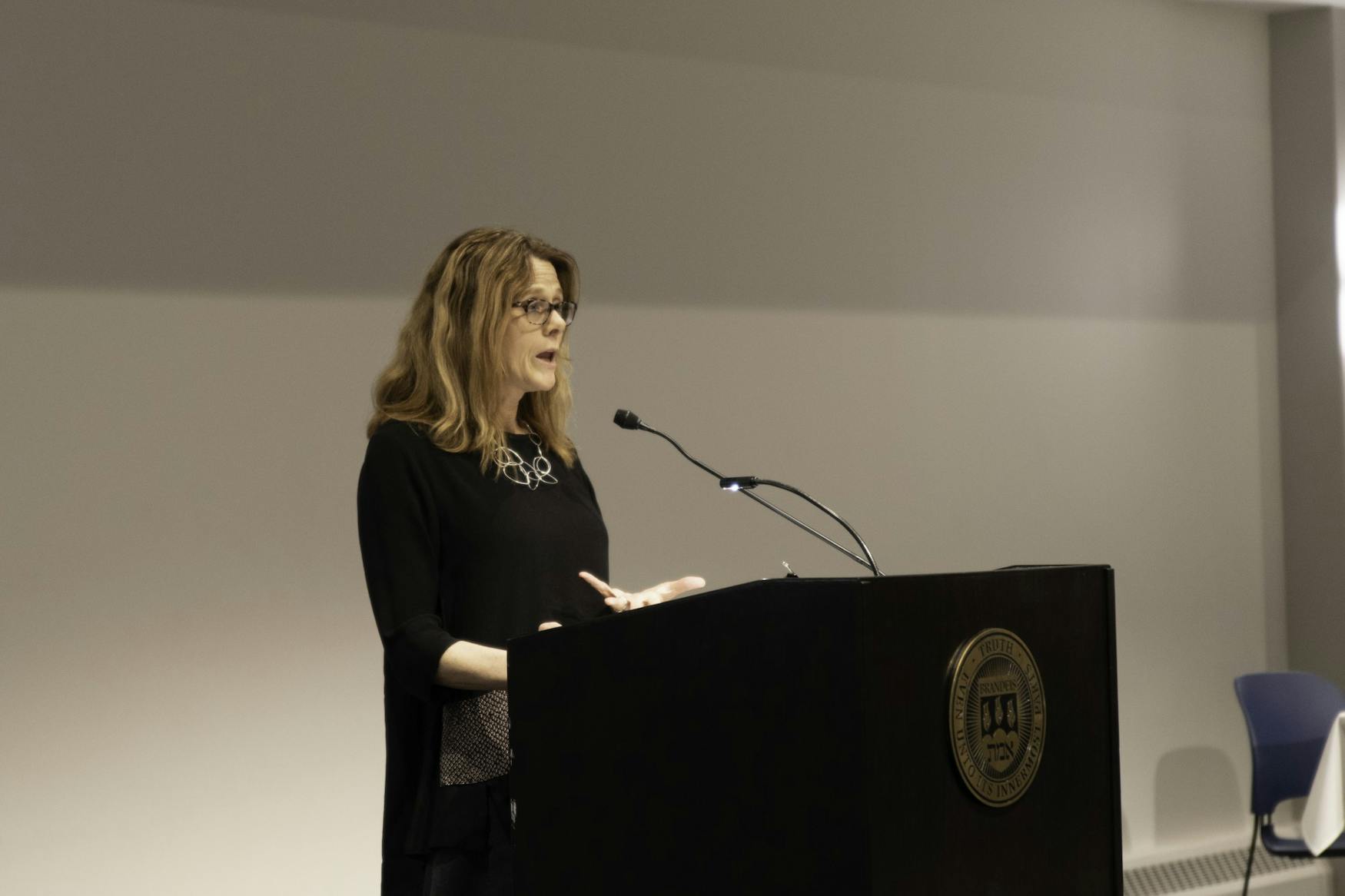Expert shares findings on education research
Prof. Susan Eaton discussed conclusions she drew from her research about about racial equity in education.
Prof. Susan Eaton (Heller) spoke on Thursday about her research on efforts to promote racial and ethnic equity and inclusion in U.S. K-12 schools in a keynote lecture entitled “Getting to ‘We’: Educators as a Counterforce to Othering in a Polarized Nation.”
Eaton began her presentation with a look at the “two-way immersion” programs created in Heber City, UT to promote bilingual education among Latinx and white students. While many language programs focus on teaching English to Spanish-speaking Latinx students, two-way immersion programs, also known as dual-language programs, are uniquely strong in Utah and seek to create a bilateral exchange of language and literacy skills so that English-speaking students learn Spanish as well.
Gregg Roberts, a dual language specialist for the Utah State Board of Education and the “architect” of two-way immersion programs, quoted by Eaton, said that the programs change the narrative around English language learning. “It’s not this crazy idea anymore of ‘them’ needing to adapt to ‘us’,” Roberts said. Instead, both groups can learn from each other.
Eaton also discussed her research on the Hazleton One Community Center in Hazleton, PA, which was created in response to a law permitting anti-immigrant discrimination for housing and employment passed in the small former coal town in 2006. Though the law was struck down by the U.S. Third Circuit Court of Appeals in 2010, many in the community still harbored resentment against Latinx immigrants whom they believed were the cause of the town’s economic struggles. The community center is part of the Hazleton Integration Project, an organization whose goal is to “repair some of what has been damaged here by building bridges” between people of different ethnic and cultural backgrounds, according to executive director Ben Medina, quoted by Eaton. The project was sponsored by the Los Angeles Angels manager Joe Maddon, who was concerned by the racial division he noticed in his hometown of Hazleton.
Another effort that Eaten researched is based in New York City, which is home to some of the most racially segregated schools in the nation, according to the ACLU. Through the organization Integrate NYC, students in the city are helping to shape school integration projects and research. These students “have identified what real integration is, as opposed to mere desegregation,” Eaton said. According to the organization, integration can be understood through “five Rs:” race and enrollment, resources, relationships between groups, restorative justice and representation within school faculty. In particular, restorative justice is a response to a consensus among social scientists that punitive measures, as Eaton put it, “one, don’t work; two, are prone to racism and all sorts of -isms; and that they don’t lend themselves to cultures of belonging.” Instead, restorative justice measures strive to retain the offending student as a member of the school community, allowing the student to work to repair the harm they caused to the school community.
Some educators who attended the event pointed out that these success stories are not fully representative of the status of diversity and inclusion in education, and Eaton agreed. Jamel Sharif, a philosophy professor at Merrimack College and a former principal, asked Eaton to “illuminate the Native American perspective” on the two-way immersion language program in Utah. Eaton said that when program proponents were asked about any language initiatives for Native students, many of them simply said, “I don’t know,” indicating they were not aware of nor promoting any such programs.
Maria Rivera Maulucci, a professor of education at Barnard College, said that two-way immersion programs in New York City often have unequal effects, with white students benefiting more from bilingual education then Latinx students. Eaton acknowledged that “there’s still a lot of things that need to be tended to before it’s a truly equitable system,” particularly given that American organizations working toward social justice are necessarily built on the foundations of a “white-supremacist, racist society,” she said. Nonetheless, Eaton emphasized the importance of being “intentionally hopeful” when working to enact change in what can seem like a hopeless situation.
Eaton’s lecture was presented as part of an annual two-day conference for the Consortium for Excellence in Teacher Education, hosted this year by Brandeis. The conference seeks to improve teacher education through “roundtable discussions about problems and practice in teaching,” presentations of research and panel discussions, according to Rachel Kramer Theodorou, a senior lecturer in the Brandeis Education department. Theodorou noted that there are many courses focused on social justice available in both the undergraduate and graduate education programs, including a class on using diverse literature to teach understanding among elementary school students.
Eaton is a professor of Practice in Social Policy and the director of the Sillerman Center for the Advancement of Philanthropy at the Heller School for Social Policy and Management. The presentation Eaton gave was derived from research she conducted for her book, “Integration Nation: Immigrants, Refugees, and America at Its Best,” which focuses on efforts to welcome immigrants into American communities, as well as her storytelling project, “One Nation Indivisible,” which chronicles the stories of people working toward equity and inclusion in education.




Please note All comments are eligible for publication in The Justice.